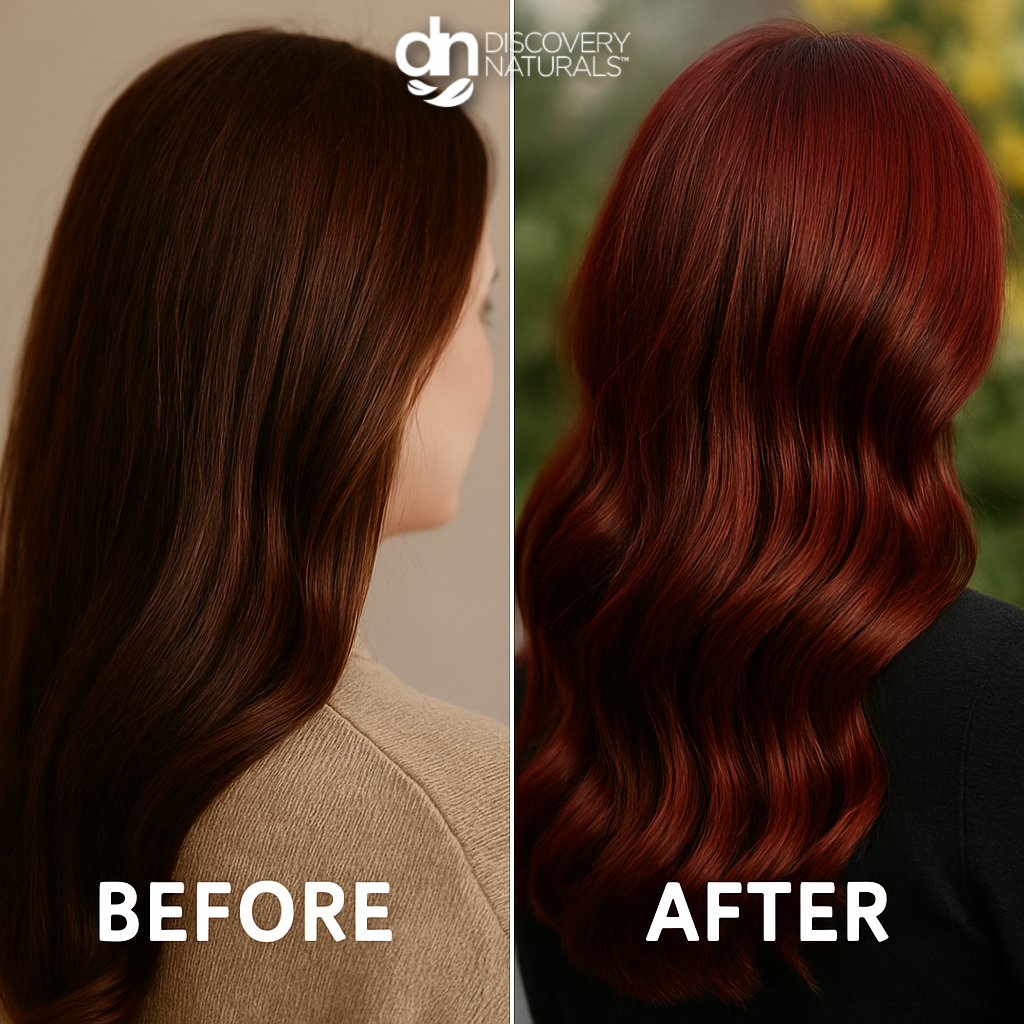Dark red hair dye made with henna and plant-based herbs is the safest way to achieve a rich, lasting crimson or burgundy shade. Unlike chemical dyes, henna coats and strengthens your hair, fades naturally, and lasts 4–6 weeks without harsh regrowth lines.
Table of Contents
What Makes Dark Red Hair Dye Unique?
Dark red is one of the most sought-after hair shades because it balances intensity and versatility. While bright reds can feel bold and attention-grabbing, and wine or burgundy shades lean cooler, dark red provides the perfect deep warmth that flatters a wide range of skin tones.
-
On lighter hair, dark red produces vibrant, fiery results.
-
On medium brown hair, it enhances undertones with richness and shine.
-
On dark hair, it creates dimension, especially in sunlight.
The versatility of this shade is why it consistently trends on social media, red carpets, and in salons. But unlike salon chemical treatments, plant-based dyes let you achieve this look safely at home—without long-term hair damage.
Dark Red vs. Wine Red—Which Should You Choose?
If you’ve been debating between dark red and wine red, you’re not alone—many people confuse the two. Both shades are gorgeous but have distinct undertones:
-
Dark Red → A classic, true red with warm richness. Best for those who want noticeable but natural vibrancy.
-
Wine Red → A deeper, cooler-toned red with hints of purple or burgundy. Best for those seeking elegance with less brightness.
Want to dive deeper into wine tones? We’ve written two complete guides that break it down further:
By interlinking both shades, you not only help readers decide but also strengthen your site’s topical authority on red dyes.
Why Natural Henna-Based Dyes Win
Traditional dark red dyes are often packed with ammonia, PPD, and metallic salts—all of which damage the cuticle, dry the scalp, and can trigger allergic reactions. In contrast, henna-based dark red dye:
-
Coats the hair shaft instead of penetrating and breaking it down.
-
Provides conditioning benefits for softer, shinier strands.
-
Fades gradually and evenly, avoiding the harsh regrowth line.
-
Offers customizable results—from subtle crimson to bold burgundy—depending on your base color and number of applications.
By combining pure henna with complementary herbs like indigo and amla, Discovery Naturals creates deep, multidimensional reds that last without the risks of synthetic dye.
The Benefits of Plant-Based Dark Red Dye
Switching to natural hair dye isn’t just about avoiding chemicals—it comes with real benefits:
Healthier Hair Over Time
Henna strengthens the hair cuticle, reduces split ends, and adds natural shine. Many users report their hair feels thicker and fuller after regular use.
Effective Gray Coverage
Henna binds to gray strands, turning them into radiant copper or blending them seamlessly into dark red tones. Instead of standing out, grays become part of the overall color.
Eco-Friendly & Sustainable
Unlike chemical dyes that produce harmful runoff, plant-based dyes are biodegradable and safe for home use.
Cost-Effective
Salon red coloring can cost hundreds of dollars per session. With natural dyes, you achieve salon-level results at home for a fraction of the price.
Beard-Friendly
Men can use dark red dye for beards to add depth or cover grays—without irritation or harsh chemicals near the skin.
Step-by-Step: Applying Dark Red Natural Dye
Applying henna-based dark red dye at home is straightforward. Here’s a simple process to follow:
-
Prep your hair – Wash with a gentle, sulfate-free shampoo. Avoid conditioner before application, as it may coat the strands.
-
Mix your dye – Blend the powdered mix with warm water (or brewed tea for deeper tones) until it forms a yogurt-like paste.
-
Section & apply – Divide hair into small parts, applying from root to tip for even coverage.
-
Cover & wait – Wrap hair with a shower cap and let the color develop for 1–2 hours.
-
Rinse thoroughly – Use water only. Avoid shampoo for 24 hours to let the color oxidize fully.
-
Final result – Hair will appear brighter immediately and deepen over the next 48 hours.
Maintaining Your Deep Red Shade
Red tones fade faster than darker shades, so proper care is key. Here’s how to extend your color:
-
Wash with sulfate-free shampoo to avoid stripping natural oils.
-
Rinse with cool water—hot water opens cuticles and fades dye faster.
-
Use UV-protectant sprays if spending long hours outdoors.
-
Reapply every 4–6 weeks to refresh and intensify the red tones.
-
Avoid chlorine-heavy pools, which can dull the richness of the shade.
FAQs About Plant-Based Dark Red Dye
Does dark red henna dye cover gray hair?
Yes—henna binds to gray hair, turning it a coppery red at first, and blending with repeated applications into a deeper crimson or burgundy.
Is dark red dye safe for sensitive scalps?
Absolutely. Our formulas contain no ammonia, PPD, or metallic salts, making them safe even for sensitive skin.
Will dark red show on naturally dark brown or black hair?
Yes, but results will be more subtle. In sunlight, strands will glow with a rich red tone, while indoors the effect will appear deeper and more natural.
Can I mix dark red henna with indigo?
Yes! Combining henna and indigo can shift undertones toward cooler burgundy or even near-black shades with red highlights.
Explore Related Blogs & Products
-
Dark red hair dye delivers bold yet natural vibrancy that suits many skin tones.
-
Henna-based dyes are safer, condition hair, and fade gradually without damage.
-
Gray coverage is seamless, and repeated applications deepen richness.
-
Works for both hair and beards, making it versatile for men and women.
-
Lasts 4–6 weeks, with easy at-home reapplication.
Ready for a natural, chemical-free transformation? Shop our Natural Dark Red Hair Colors today.



